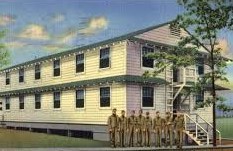April 18 – April 24The Week in Indiana History |
||||||||||||||||
“It was horrible—too horrible to describe. Never shall I cross the sea again.” – – – Ellen Toomey (1874-1933) A resident of Indianapolis, she survived the sinking of the Titanic in 1912. Take an “Armchair Tour” of the Indiana Statehouse Did You Know?   Herb Shriner was born in Toledo, Ohio. However, his family moved to Indiana, as he used to say, “as soon as they heard about it.” Growing up in Fort Wayne, he learned to play the harmonica and began performing for local audiences. One night his lip gave out, and he completed the program by telling homespun stories. The stories made people laugh, and soon Herb found a niche for himself in show business. He had his own network radio show in 1940. That led to television, where he had his own show and made guest appearances on many others. He would play a quick tune on the harmonica and then talk about folks back home. He even hosted a game show called “Two for the Money.”    He and his wife Ellen had three children: a girl named Indy (for Indianapolis,) and twin boys, Wil and Kin Shriner. Wil is an actor, comedian, and TV producer. Kin is an actor on soap operas.   Quip from Herb Shriner: My hometown had one big trouble: Not enough get-up-and-go. Actually, we’d get up, but there wasn’t anyplace to go.  ANSWERS: 1.  a   2. b  3. d
|
||||||||||||||||





 1902   President Theodore Roosevelt sent a note to Secretary of War Elihu Root suggesting that the new Army post in Indianapolis be named for President Benjamin Harrison. Roosevelt had served under Harrison as Civil Service Commissioner. The fort was active for 85 years and is still the site of the Defense Finance and Accounting Center. The grounds have been developed into a state park.
1902   President Theodore Roosevelt sent a note to Secretary of War Elihu Root suggesting that the new Army post in Indianapolis be named for President Benjamin Harrison. Roosevelt had served under Harrison as Civil Service Commissioner. The fort was active for 85 years and is still the site of the Defense Finance and Accounting Center. The grounds have been developed into a state park. 1912   Indianapolis resident Ellen Toomey returned to her home on Bates Street, having survived the sinking of the Titanic. She had been on a visit to Ireland to see her mother and two sisters. She booked passage for the return trip on the Titanic. When the ship struck an iceberg and began to sink, she was placed in a lifeboat with 30 other people. They drifted on the dark sea for seven hours before being rescued by another ship, the Carpathia.
1912   Indianapolis resident Ellen Toomey returned to her home on Bates Street, having survived the sinking of the Titanic. She had been on a visit to Ireland to see her mother and two sisters. She booked passage for the return trip on the Titanic. When the ship struck an iceberg and began to sink, she was placed in a lifeboat with 30 other people. They drifted on the dark sea for seven hours before being rescued by another ship, the Carpathia. 1939  Langston Hughes and Arna Bontemps, noted African American poets and authors, were guest speakers at the Indianapolis YWCA on North Pennsylvania Street. Hughes (left) spoke about his experience as a journalist covering the Spanish Civil War. Bontemps discussed his recent book, Haiti, Mysterious Island.  The event was sponsored by the Progressive Art League of Indiana.
1939  Langston Hughes and Arna Bontemps, noted African American poets and authors, were guest speakers at the Indianapolis YWCA on North Pennsylvania Street. Hughes (left) spoke about his experience as a journalist covering the Spanish Civil War. Bontemps discussed his recent book, Haiti, Mysterious Island.  The event was sponsored by the Progressive Art League of Indiana.



